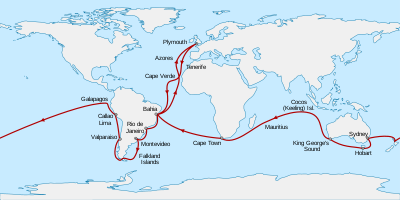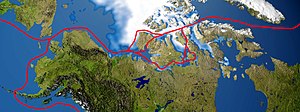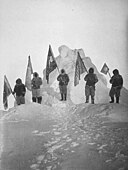Major explorations after the Age of Discovery
Major explorations of
Voyages into the continents took longer. The centers of the
History
James Cook's Pacific Ocean exploration (1768–1779)

British explorer James Cook, who had been the first to map the North Atlantic island of Newfoundland, spent a dozen years in the Pacific Ocean. He made great contributions to European knowledge of the area, and his more accurate navigational charting of large areas of the ocean was a major achievement.
Cook made three voyages to the Pacific, including the first European contact with the eastern coastline of Australia and the Hawaiian Islands (although oral tradition seems to point towards a far earlier Spanish expedition having achieved the latter), as well as the first recorded circumnavigation of New Zealand.[1]
Cook was the first European to have extensive contact with various people of the Pacific. He correctly concluded there was a relationship among all the people in the Pacific, despite their being separated by thousands of miles of ocean (see Malayo-Polynesian languages). In New Zealand the coming of Cook is often used to signify the onset of colonization.[2][3] He also theorised that Polynesians originated from Asia, which was later proved to be correct by scientist Bryan Sykes.[4]
Cook was accompanied by many scientists, whose observations and discoveries added to the importance of the voyages. Two botanists went on the first voyage, Englishman
Mapping and measuring
To create accurate maps,
Cook gathered accurate longitude measurements during his first voyage with the help of astronomer
Scientific Surveys in Central America and the Pacific
Alexander von Humboldt (1799–1804)

Between 1799 and 1804, Baron
As a consequence of his explorations, von Humboldt described many geographical features and species of life that were hitherto unknown to Europeans and his quantitative work on
Darwin and the second voyage of HMS Beagle (1831–1836)

In December 1831 a British expedition departed under captain
FitzRoy thought of the advantages of having an expert in

Alfred Russel Wallace Amazon and Malay explorations (1848–1862)
In 1848, inspired by the chronicles of earlier traveling naturalists[8] British naturalist Alfred Russel Wallace and Henry Bates left for Brazil with the intention of collecting insects and other animal specimens in the Amazon rainforest. Wallace charted the Rio Negro for four years, collecting specimens and making notes on peoples, geography, flora, and fauna.[9] In July 1852, while returning to the UK, the ship's cargo caught fire and all the specimens he had collected were lost.[10][11]
From 1854 to 1862, Wallace traveled again through
His interest resulted in his being one of the first prominent scientists to raise concerns over the environmental impact of human activity, like deforestation and invasive species. In 1878, he warned about the dangers of deforestation and soil erosion in tropical climates, like the extensive clearing of rainforest for coffee cultivation in Ceylon (Sri Lanka) and India.[14] Accounts of his travels were published in The Malay Archipelago in 1869, one of the most popular and influential journals of scientific exploration published during the 19th century.
Interior Africa exploration
Africa's deep interiors were not explored by Europeans until the mid to late 19th and early 20th centuries; this being due to a lack of trade potential in this region, and to serious problems with contagious tropical diseases in sub-Saharan Africa's case.
David Livingstone (1849–1855)
In the mid-19th century,
Explorers were also active in other parts of the continent. Southern Morocco, the Sahara and the Sudan were traversed in many directions between 1860 and 1875 by Georg Schweinfurth and Gustav Nachtigal.[15] These travellers not only added considerably to geographical knowledge, but obtained invaluable information concerning the people, languages and natural history of the countries in which they sojourned. Among the discoveries of Schweinfurth was one that confirmed Greek legends of the existence beyond Egypt of a "pygmy race". But the first western discoverer of the pygmies of Central Africa was Paul Du Chaillu, who found them in the Ogowe district of the west coast in 1865, five years before Schweinfurth's first meeting with them. Du Chaillu had previously, through journeys in the Gabon region between 1855 and 1859, made popular in Europe the knowledge of the existence of the gorilla, whose existence was thought to be legendary.
Henry Morton Stanley, who had in 1871 succeeded in finding and rescuing Livingstone (originating the famous line "Dr. Livingstone, I presume"), started again for Zanzibar in 1874. In one of the most memorable of all exploring expeditions in Africa, Stanley circumnavigated Victoria Nyanza and Tanganyika. Striking farther inland to the Lualaba, he followed that river down to the Atlantic Ocean—which he reached in August 1877—and proved it to be the Congo.
Serpa Pinto, Capelo, and Ivens (1877–1886)
Portuguese Serpa Pinto was the fourth explorer to cross Africa from west to east and the first to lay down a reasonably accurate route between Bié (in present-day Angola) and Lealui. In 1877, Serpa Pinto and Portuguese naval captains Capelo and Ivens explored the southern African interior starting from Benguela. Capello and Ivens turning northward whilst Serpa Pinto continued eastward. He crossed the Cuando (Kwando) river in June 1878 and in August reached Lealui, the Barotse capital on the Zambezi.
From 1884 to 1886,
Exploring the Arctic and Antarctic
Arctic and Antarctic seas were not explored until the 19th century. Once the North Pole had been reached in 1909, several expeditions attempted to reach the South Pole. Many resulted in injury and death. The Norwegian Roald Amundsen finally reached the Pole in December 1911, following a dramatic race with the Englishman Robert Falcon Scott.
The Northwest Passage

The Northwest Passage is a sea route connecting the Atlantic and Pacific Oceans through the
In the first half of the 19th century, parts of the Northwest Passage were explored separately by a number of different expeditions, including those by
The Northwest Passage was not completely conquered by sea until 1906, when the Norwegian explorer Roald Amundsen, who had sailed just in time to escape creditors seeking to stop the expedition, completed a three-year voyage in the converted 47-ton herring boat Gjøa. At the end of this trip, he walked into the city of Eagle, Alaska, and sent a telegram announcing his success. His route was not commercially practical; in addition to the time taken, some of the waterways were extremely shallow.[19]
The North Pole (1909–1952)

While the South Pole lies on a continental land mass, the North Pole is located in the middle of the Arctic Ocean amidst waters that are almost permanently covered with constantly shifting sea ice.
A number of expeditions set out with the intention of reaching the North Pole but did not succeed; that of British naval officer William Edward Parry, in 1827, the American Polaris expedition in 1871, and Norwegian Fridtjof Nansen in 1895. American Frederick Albert Cook claimed to have reached the North Pole in 1908, but this has not been widely accepted.[citation needed]
The conquest of the North Pole was for many years credited to American Navy engineer Robert Peary, who claimed to have reached the Pole on April 6, 1909,[16] accompanied by American Matthew Henson and four Inuit men named Ootah, Seeglo, Egingwah, and Ooqueah. However, Peary's claim remains controversial.[20][21] The party that accompanied Peary on the final stage of the journey included no one who was trained in navigation and could independently confirm his own navigational work, which some claim to have been particularly sloppy as he approached the Pole. He traveled with the aid of dogsleds and three separate support crews who turned back at successive intervals before reaching the Pole. Many modern explorers, contend that Peary could not have reached the pole on foot in the time he claimed.
The first undisputed sighting of the Pole was on May 12, 1926 by
Antarctica exploration

Early Western theories believed that in the far south of the globe existed a vast continent, known as Terra Australis. The rounding of the Cape of Good Hope and Cape Horn in the 15th and 16th centuries proved that Terra Australis Incognita ("Unknown Southern Land"), if it existed, was a continent in its own right. The basic geography of the Antarctic coastline was not understood until the mid-to-late 19th century.
It may safely be said that all the navigators who fell in with the southern ice up to 1750 did so by being driven off their course and not of set purpose. An exception may perhaps be made in favor of
The obsession of the undiscovered continent culminated in the brain of Alexander Dalrymple, a hydrographer who was nominated by the Royal Society to command the Transit of Venus expedition to Tahiti in 1769. The command of the expedition was given by the admiralty to Captain James Cook. Sailing in 1772 with the Resolution and the Adventure under Captain Tobias Furneaux, Cook first searched in vain for Bouvet Island, then sailed for 20 degrees of longitude to the westward in latitude 58° S, and then 30° eastward for the most part south of 60° S, a higher southern latitude than had ever been voluntarily entered before by any vessel. On 17 January 1773 the Antarctic Circle was crossed for the first time in history and the two ships reached 67°15′S 39°35′E / 67.250°S 39.583°E, where their course was stopped by ice.[22]
The first land south of the parallel 60° south latitude was discovered by the Englishman William Smith, who sighted Livingston Island on 19 February 1819.
In 1820, several expeditions claimed to have been the first to have sighted Antarctica. The first confirmed sighting of mainland Antarctica cannot be accurately attributed to one single person. It can, however, be narrowed down to three individuals. According to various sources,
Only slightly more than a year later, the first landing on the Antarctic mainland was arguably by the American Captain John Davis, a sealer, who claimed to have set foot there on 7 February 1821, though this is not accepted by all historians.[26][failed verification]
The South Pole (1911)

After the
Once the North Pole had been reached in 1909, several expeditions attempted to reach the South Pole. Many resulted in injury and death. The Norwegian Roald Amundsen reached the Pole in December 1911, following a race with the Englishman Robert Falcon Scott.
The first attempt to find a route to the South Pole was made by British explorer
The first humans to reach the South Pole were
In 1914 Ernest Shackleton's Imperial Trans-Antarctic Expedition set out with the goal of crossing Antarctica via the South Pole, but his ship, the Endurance, was frozen in pack-ice and sank 11 months later. The overland journey was never made.
See also
- Vermeer's Hat: The Seventeenth Century and the Dawn of the Global World
- United States Exploring Expedition (1838 to 1842)
- Spanish expeditions to the Pacific Northwest
References
- ^ Beazley, Charles Raymond (1911). . In Chisholm, Hugh (ed.). Encyclopædia Britannica. Vol. 7 (11th ed.). Cambridge University Press. pp. 71–72.
- ^ a b per Collingridge (2002)[full citation needed]
- ^ per Horwitz (2003)[full citation needed]
- ISBN 0-393-02018-5.
- ^ Wulf, Andrea (2016). The Invention of Nature: Alexander von Humboldt's New World. Knopf Doubleday Publishing Group. pp. 120–133.
- ISBN 9780313320439.
- ISBN 978-0-14-043268-8
- ^ Slotten The Heretic in Darwin's Court pp. 34–37.
- ^ Raby Bright Paradise pp. 89–95.
- ^ Wilson pp. 42–43.[full citation needed]
- ^ Slotten pp. 87-88[full citation needed]
- ^ Shermer In Darwin's Shadow pp. 14.
- ^ Smith, Charles H. "Alfred Russel Wallace: Evolution of an Evolutionist Introduction". The Alfred Russel Wallace Page hosted by Western Kentucky University. Retrieved 2007-04-27.
- ^ Slotten pp. 352–353.[full citation needed]
- ^ "Sahara and Sudan: The Results of Six Years Travel in Africa". World Digital Library. 1879–1889. Retrieved 2013-10-02.
- ^ a b "ARCTIC EXPLORATION - CHRONOLOGY". Quark Expeditions. 2004. Archived from the original on 2008-11-20. Retrieved 2006-10-19.
- ^ Burton, p. 219.[full citation needed]
- ^ Richards, R. L. (2000). "John Rae". Dictionary of Canadian Biography Online. Retrieved 2006-10-20.
- ^ "Northwest Passage". The Canadian Encyclopedia. 2006. Archived from the original on 2007-01-02. Retrieved 2006-10-20.
- ^ "ARCTIC, THE". Columbia Encyclopedia, Sixth Edition. Columbia University Press. 2004. Retrieved 2006-10-19.
- ^ "North Pole". The Canadian Encyclopedia. 2006. Retrieved 2006-10-20.
- ^ a b One or more of the preceding sentences incorporates text from a publication now in the public domain: Mill, Hugh Robert (1911). "Polar Regions". In Chisholm, Hugh (ed.). Encyclopædia Britannica. Vol. 21 (11th ed.). Cambridge University Press. pp. 961–962.
- ^ U.S. Antarctic Program External Panel. "Antarctica —past and present" (PDF). NSF. Retrieved 2007-11-14.
- ^ Guthridge, Guy G. "Nathaniel Brown Palmer". NASA. Archived from the original on 2006-02-02. Retrieved 2007-11-14.
- ^ "AARC Palmer Station Info". Archived from the original on 2006-08-28. Retrieved 2006-08-28.
- ^ Headland, R.K. "Summary of the Peri-Antarctic Islands". Scott Polar Research Institute. Retrieved 2007-11-14.
- ^ Science into Policy: Global Lessons from Antarctica, p. 37, Paul Arthur Berkman, 2002
- ^ Antarctica, p. 24, Paul Simpson-Housley, 1992
